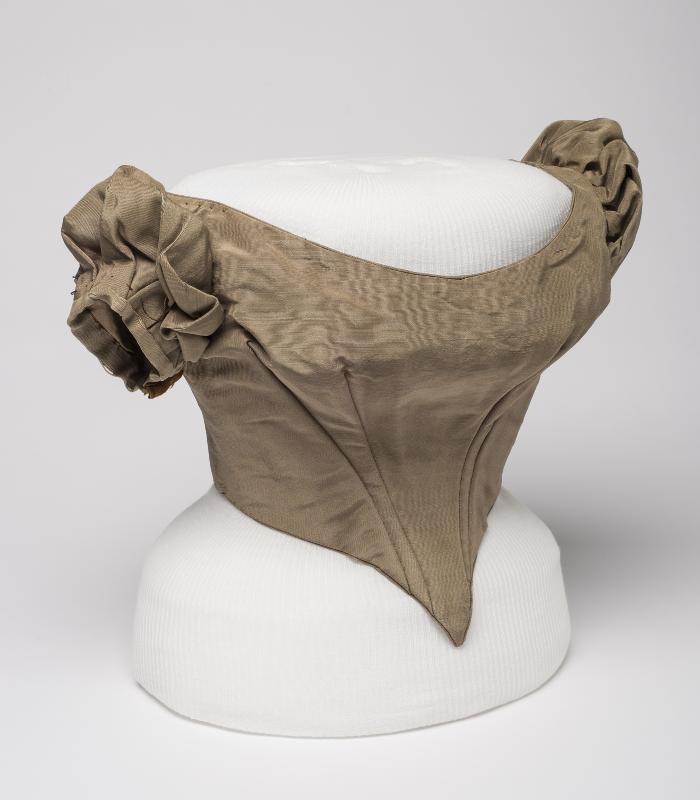Textile: Bodice belonging to M. Lavinia Warren
1862 – 1865 (Date manufactured/created)
Textile and Personal Artifact
Measurement Notes: overall width: 14.5"; waistline: 18 3/4"; CB: 8.5"; CF 8.5"
Dress bodice originally worn by M. Lavinia Warren, better known as "Mrs. General Tom Thumb." It dates to around the time of her marriage to Charles S. Stratton ("General Tom Thumb") in 1863. A bodice is a fitted upper body garment created as part of a full gown, with the skirt typically made of the same fabric. This bodice is made of taupe color faille (pronounced "file") which is a finely ribbed silk material. It features short, puffed sleeves, a deeply pointed waist at the front and back, and a wide, curved neckline. It is laced up the back, and would have been worn over a corset, making the wearer's waist appear as tiny as possible. The inside is lined in brown cotton, and reveals the many seams required to make a garment contoured to the figure. There are stitched slots in the lining where boning is inserted to keep the bodice smooth while being worn. Remaining snippets of sewing threads and fragments of ribbon are clues that the bodice was originally trimmed with brown velvet ribbon and it probably featured lace around the neckline and sleeve openings. Women's fashions of the early 1860s focused on a very full, wide skirt worn over a hoop skirt and petticoats, and a bodice with a round neck, front buttons and long sleeves for daywear, or a short-sleeved, low-necked bodice like this one for evening wear. Unfortunately the full-length matching skirt no longer exists.
M. Lavinia Warren was a well known entertainer, whose career spanned the 1860s to the early 1900s. She was born Mercy Lavinia Warren Bump on October 31, 1841, in Massachusetts. She married fellow entertainer Charles S. Stratton on Feburary 10, 1863, and following his death in 1883, she married an Italian entertainer of a similar stature, Count Primo Magri, on April 6, 1885. Warren was a schoolteacher originally but soon began her performance career on a river boat at at time when exhibiting people with dwarfism was profitable. Warren signed with showman P. T. Barnum at age 21, along with her younger sister Minnie (Huldah) Warren, who also had dwarfism. After her marriage to Stratton the two toured the country and around the world giving performances, becoming America's first international celebrity couple. During Warren's second marriage, she and her husband also toured for many years and later operated a roadside stand in Middleboro, Massachusetts, her birthplace. Lavinia Warren Stratton Magri died on November 25, 1919, and was buried beside Stratton at Mountain Grove Cemetery in Bridgeport, Connecticut.
M. Lavinia Warren was a well known entertainer, whose career spanned the 1860s to the early 1900s. She was born Mercy Lavinia Warren Bump on October 31, 1841, in Massachusetts. She married fellow entertainer Charles S. Stratton on Feburary 10, 1863, and following his death in 1883, she married an Italian entertainer of a similar stature, Count Primo Magri, on April 6, 1885. Warren was a schoolteacher originally but soon began her performance career on a river boat at at time when exhibiting people with dwarfism was profitable. Warren signed with showman P. T. Barnum at age 21, along with her younger sister Minnie (Huldah) Warren, who also had dwarfism. After her marriage to Stratton the two toured the country and around the world giving performances, becoming America's first international celebrity couple. During Warren's second marriage, she and her husband also toured for many years and later operated a roadside stand in Middleboro, Massachusetts, her birthplace. Lavinia Warren Stratton Magri died on November 25, 1919, and was buried beside Stratton at Mountain Grove Cemetery in Bridgeport, Connecticut.
T 2015.001.001
